


Freebies
The Freebies are plug-in filters for Photoshop and other paint programs. They change colors in simple ways and you can use them free of charge.
To use this software, you need a paint program which accepts standard Photoshop 3.0 plugins.
Just put the plug-in filters into the folder where your paint program expects to find them. If you have Photoshop, the folder is Photoshop:Plugins:Filters or Photoshop:Plug-ins. You must restart Photoshop before it will notice the new plug-ins. They will appear in the menus under Filters->Flaming Pear.
Most other paint programs follow a similar scheme.
If you have Paint Shop Pro: you have to create a new folder, put
the plug-in filter into it, and then tell PSP to look there. In
PSP 5 or PSP 6: choose the menu File-> Preferences->General Program
Preferences... and choose the Plug-in Filters tab. In PSP 7: choose
the menu File-> Preferences->File Locations... and choose the
Plug-in Filters tab.
Use one of the "Browse" buttons to choose the folder mentioned
above.
From PSP's menus, choose the plugin. For example, choose Image->Plug-in
Filters->Flaming Pear->Tachyon. If you have PSP 7, look in Effects->Plug-in
Filters->Flaming Pear->Tachyon.
These filters only do one effect apiece, so they have no controls.
Here are some example effects that you can do. Open a favorite picture for these examples -- you won't see anything if you start with a blank canvas. Select part of the picture, and invoke a filter.
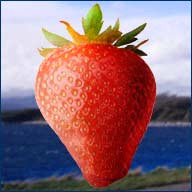
Original image
Tachyon ("Tak-ee-on," a faster-than-light particle) inverts the
the bright and dark areas of your picture, but does not change
the hues. Ordinary inversion would change blue to yellow, for
example.

Tachyon
ChromaSolarize combines the Tachyon effect with solarization,
which produces attractive surreal effects.
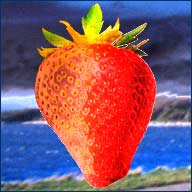
ChromaSolarize
Exchanges the left-eye and right-eye channels in red/cyan anaglyphic
3D pictures.
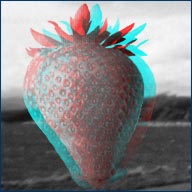
Anaglyph Flip
Swap Red & Green Swap Green & Blue These filters work on RGB images – those with three channels of
color: red, green, and blue. By swapping data between channels,
they transform color, changing the picture’s chromatic harmonies
in useful ways.

Swap Red & Blue
RGB->HSL takes a normal image with its red, green, and blue color
channels and replaces these with hue, saturation, and luminance
respectively. Your paint program will think the image is still
in RGB form, so the colors will look bizarre. HSL->RGB changes
the image back. The HSL color system is a way of representing colors. Hue is the
property of a color that classifies it as red, yellow, blue or
green, or a blend of these. Saturation is the vividness of the
color; and luminance is the total amount of light it throws off. If you use these filters and your paint program lets you paint
into individual color channels, you can change the image in a
way difficult to do in RGB mode. Try Using RGB->HSL, then Gaussian Blur, then HSL->RGB.

RGB->HSL and HSL->RGB
Vitriol changes colors’ contrast as if viewed through colored
glass, but without tinting the image. Imagine you want to use black-and-white film to take a spooky
picture of a landscape. You could make the sky unnaturally dark
by placing a yellow glass filter over the lens; this will make
the blue sky very dark, while the appearance of the green landscape
is affected very little. It would be fun to do the same effect in color. But the yellow
filter would of course make the picture yellowish. But Vitriol
will get the contrast effect without the colorization. Just set
the foreground color to the color of the imaginary colored glass,
and choose Vitriol from the Filter menu. Vitriol automatically provides density correction, so you can
use a strongly colored filter without making your picture go dark.
The effect is most vivid on areas of strongly saturated color;
apply repeatedly to intensify the result.

Vitriol
Kyoto Color Chages color using a Hue/Luminance/Saturation color
space, but it's not the same HLS color space built into Photoshop.
The Kyoto space produces more lifelike results for massive hue
changes.

Kyoto Color
Ornament takes a photo of a mirrored ball and unwraps the reflection
into a form called an "equirectangular panorama." It has its own separate guide.

Ornament
The next filters only operate on layers with a transparency channel.
Solidify turns an image layer entirely 100% opaque. It reveals
partially transparent areas, and can even help repair the corrupted
transparency channel that some paint programs occasionally produce.
It's also good for quickly filling in missing regions of a panorama. In this example, the strawberry was in a different layer than
the background.
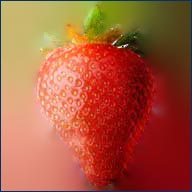
Solidify
Ghost turns an image layer into a semitransparent picture made
entirely of black pixels. It produces a smoked-glass effect that's
hard to produce by hand. In this example, the strawberry was in a different layer than
the background.

Ghost
TransLine makes every second scanline transparent. TransTone is
similar, but turns a 50% pattern of pixels transparent. This can
be a useful effect if you are making transparent GIFs for the
web. In this example, the strawberry was in a different layer than
the background.
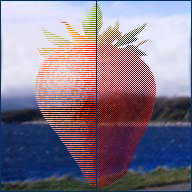
TransLine and TransTone
Flaming Pear Software has more complex filters available here. They all come with a free trial period, after which they can be purchased online or off.
Answers to common technical questions appear on the support page, and free upgrades appear periodically on the download page.
Trouble with your order? Orders are handled by Kagi, which can be reached at admin@kagi.com .
For bug reports and technical questions about the software, please write to support@flamingpear.com .